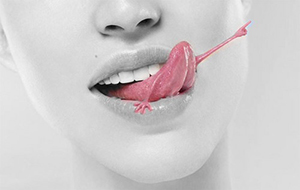
Are you in a state of media overshock after this gratuitous display of tongue-adge on a certain video awards show? No? But it may give you pause to think about all the naughtiness that tongues present to you as a dental clinician on a daily basis.
Most tongues behave themselves very well when you’re working in their realm. It IS the tongue’s kingdom after all; the mouth is where this majestic muscle rules supremely, preventing any dangerous objects from being inhaled or swallowed. However, there are some tongues that simply won’t cooperate, no matter how much you comfort and reassure them. See if you recognize any of these personalities in the tongues you have worked with.
The Stalker
This is a tongue that hangs back, ominously, but sort of follows you a tiny bit, like it’s planning to MURDER you while you’re simply blowing an occlusal surface dry. It is the godfather of tongues, so you had better not refuse its offer of allowing you to LIVE.
![]()
The Fist
If you encounter The Fist, you will be lucky to gain power over it. Usually appears when you’re working on an upper posterior tooth. The tongue will ball up and tighten so hard that you cannot wedge anything, not even oxygen itself, between the tooth and the tongue.
The Dive Bomber
You know you’re working with a Dive Bomber tongue when the tip of it continuously pounds you from every direction. It wouldn’t be surprising at all if the patient were actually whistling downward and making the CRRR crash sound with every hit. Your dentistry may feel like the crumbled buildings in Space Invaders by the time this appointment is over.
![]()
The Wave
A tongue doing The Wave is bad. Not that it’s doing anything to get in your way, but when the ripple of peristaltic action starts quivering along the rim of the tongue, that usually means that the patient is about a half-second away from a gag and a wretch. Have your high-speed suction available for…um…incidentals.
![]()
The Bulldozer
Everyone has had experience with this tongue. It’s one big bully, pushing you around, scooping up the rubber dam clamp and pelting it against the wall before you even consider straightjacketing it with your square of latex. The Bulldozer will warp impression vinyl into a freakshow of “was that a human or an octopus?” when questioned by your lab, and is generally violent towards anything you try to put in the attached patient’s mouth.
![]()
The Lover
This tongue is so embarrassing! You’re working along, minding your manners, when it just sort-of slinks up the handle of your mouth mirror and begins pole dancing. Worst of all is seeing this happen to a straight male dentist by an apparently straight male patient who has no idea that his tongue is lovingly caressing the tools. You just. Can’t. Say. Anything. But your assistant will, after the appointment, behind your back. Or worse, to your face.
![]()
The Exorcist
I’ve only seen The Exorcist once. Okay, twice, but it was the same patient, and I would have never believed that a tongue could move like that unless I’d seen it with my own eyes. The Exorcist stands up, perfectly straight in the center of the mouth and slowly and continuously rotates in a clockwise direction while you’re cleaning the left side of the mouth, and then stops and begins rotating in the opposite direction when cleaning the other side. The only reason I didn’t call a priest was because the patient’s health history showed she was taking some major antidepressants and schizophrenia medications.
![]()
The Puppy Dog
Like a real puppy dog, this tongue is actually kind of cute. It bounces, following you around while you’re touring a patient’s mouth, stopping to sniff while you check the edge of an old amalgam, wagging its tail when you give it a little attention. It’ll even pee on itself if it gets nervous. Yeah, you’ve seen that submandibular salivary gland gleek squirt piddle.
![]()
The Cobra
The Cobra should be heeded, but it is more of a display than an actual threat. When a patient’s tongue slowly raises up and looks like a curved shield about to strike, get out your clarinet. It’s time for a little snake charming.
![]()
The Victim
This tongue acts like it’s been maimed and waterboarded, cowering in the back of the throat like it’s trying to make itself as small as possible. You actually feel sorry for The Victim, and find yourself trying to convince the patient that you’re not the dentist from The Marathon Man, which can cause some funny looks from the oblivious. One problem with The Victim is that it may end up consoling itself by acting out its former abuse and become The Lover. NOOOOOOOOOO!
And if this is the best tongue-in-cheek humor you’ve EVER READ you need to share it now. Oh that was bad. But share, because the world needs more tongue humor, at least.
![]()
